The
new terminal at Fairbanks International Airport opened in May 2008. It is an attractive facility, at once spacious and well lit with large floor to ceiling windows that allow in plenty of natural light of which Fairbanks has an abundance during the spring and summer months. A stylish coffee stand offers food and beverages for travelers hungry or thirsty enough to pay the exorbitant prices. Alaska Airlines 737s dominate the ramp most of the year with seasonal summer visits from Northwest 757s, Delta 737-800s and Condor 767-300s. Chartered Japan Air Lines 747-400s are also spotted throughout the year.
Still, I do miss the old FAI terminal, much of which is being or will soon be demolished. I recall many a delicious and affordable meal in the full service restaurant, located at ground level where a table by the window offered superb views of the ramp and the colorful variety of aircraft that once served Fairbanks. In years past, jetliners from Wien Consolidated, Pan American, Western, Markair, United and Reno Air along with old piston engine DC-3s and C-46s from carriers like Air North, Pioneer and Audi Air made FAI a plane spotters heaven. Because the old terminal was single level, boarding meant walking out onto the ramp and climbing up the self contained stairway of a Wien 737 or entering a Western or Delta 727 through the rear stairway. To this day I can think of no more exciting way to approach and board an airliner, even in the rain.
No doubt some of you are thinking “This guy’s all wet!” but I still enjoy the sheer excitement of flight, much of which is muted when boarding via today’s modern jet bridges. Thankfully, not all of the old Fairbanks terminal has been razed. The old 1950s era building still stands and is indeed functional, serving regional carriers like ERA, Pioneer and Warbelow Air. This trip begins with a flight aboard an ERA Aviation DHC-8-100 down to Anchorage, connecting to yet another Dash 8 over to Valdez, Alaska.
April 12, 2009
ERA Aviation Fairbanks – Anchorage 2:25pm – 3:25pm DHC-8-100
ERA Aviation Anchorage – Valdez 4:50pm – 5:30pm DHC-8-100
ERA Aviation got its start in 1948 as Economy Helicopters. Its helicopters helped in surveying the Alaska Territory along with providing petroleum support services. Following a merger with Rotor Aids, Inc., the acronym ERA was born as Economy and Rotor Aids with the company known as ERA Helicopters.
ERA got into the airline business with the purchase of Jet Alaska in 1978. Three 50-passenger Convair 580s were purchased for charter/airline service, joining the company's Twin Otters and a King Air. In1988, ERA Helicopters changed its name to Era Aviation, Inc. to reflect the diversified nature of the company. Today it flies DHC-8s and Beech 1900s to a variety of Alaskan destinations, in addition to providing helicopter support services both in and outside of Alaska.
Though I’d driven to Valdez, Alaska in the early 1990s, I’d never flown there before. About three years ago a good friend of mine took a job with the city water department in Valdez and I’d yet to get back down there for a visit. ERA’s 10,000 mile in-state award made the trip both affordable and entertaining as ERA will be my 134th airline flown. I’m always up for a flight on a new airline. I’m especially looking forward to flying with Emirates, Air Seychelles and Air Madagascar. But that’s another trip.
There is no formal security checkpoint in FAI’s Terminal 1. After checking in for my flight, I proceeded unimpeded to the gate lounge. In lieu of security screening, identification is required with your boarding pass as you exit the terminal. None of the airlines operating out of Terminal 1 offer seat assignments, so those desiring a choice window or bulkhead seat best be poised and ready to go when boarding is announced.

Waiting on the ramp was N883EA, an eighteen year old DHC-8-100 that began service as D-BIRT with the German airline Interot, which became Augsburg Airways in 1995. In 2000 the aircraft was sold, donning the attractive red, white and black livery of ERA Aviation.
ERA’s Dash-8s seat 37 passengers and judging by the small group in the gate lounge, we’d all get window seats if we so desired. Not so fast said the flight attendant as we entered the aircraft and I eyed the spacious seats at emergency exit row one. Due to weight and balance considerations, no one may sit forward of row 4. Well dang! This happens to me all the time when flying on American Eagle’s ATR-72s out of Miami. Oh well, row 4 it is.
Flight time down to Anchorage was announced as one hour even. Twenty-six minutes into the flight, we flew directly over Cantwell, normally a three hour drive from Fairbanks. I could clearly see a friend’s house just a couple hundred yards up the road from the Long Branch Saloon. I missed the days of inflight telephones for it would have been fun to call and say I’m in that plane you hear overhead. I probably would have been able to see them as they ran outside to look.
Following a short layover in Anchorage, I boarded sister ship N882AS for the short 40 minute flight down the coast to Anchorage. It has been said that of all the flights within the state of Alaska, the flight between Anchorage and Valdez might be the most dramatic. Alas, we entered clouds shortly after takeoff and didn’t see land again until our approach into rainy Valdez. I took some consolation in the fact that tomorrow’s weather called for clearing skies with widely scattered sunlight later in the day.
My friend lives about 10 miles out of Valdez in a well insulated trailer surrounded by tall spruce trees. We enjoyed a good steak dinner and I finally got to photograph the notorious welcome mat that was so instrumental in driving off the unwanted attentions of Mormon and Seventh Day Adventist missionaries hell bent on converting the heathen settlers north of Valdez. After a number of such visits, my friend one day found himself in a thrift shop in Anchorage looking at a door mat that had once welcomed visitors to the home of The Tuckers. He was suddenly smitten with a bolt of inspiration. He bought the mat, took it home and carefully removed the left side of the T from Tuckers. Then he carefully glued that piece on the right side of what was left of the T. Once the glue had set, he placed the mat outside his door and has had no further visits from missionaries of any ilk.
April 13, 2009
ERA Aviation Valdez – Anchorage 8:30am – 9:10am DHC-8-100
Alaska Airlines Anchorage – Nome 11:15pm – 12:51pm 737-400
Alaska Airlines Nome – Kotzebue - Anchorage 1:36pm – 4:34pm 737-400
Alaska Airlines Anchorage – Seattle 5:05pm – 9:23pm 737-800
The one way airfare for the120 mile flight between Valdez and Anchorage is $160.00 with advance purchase. Roundtrip goes for $320.00. The alternative is a six hour, 298 mile drive over Thompson Pass and down the Glenn Highway to Anchorage. Thank goodness for award travel!
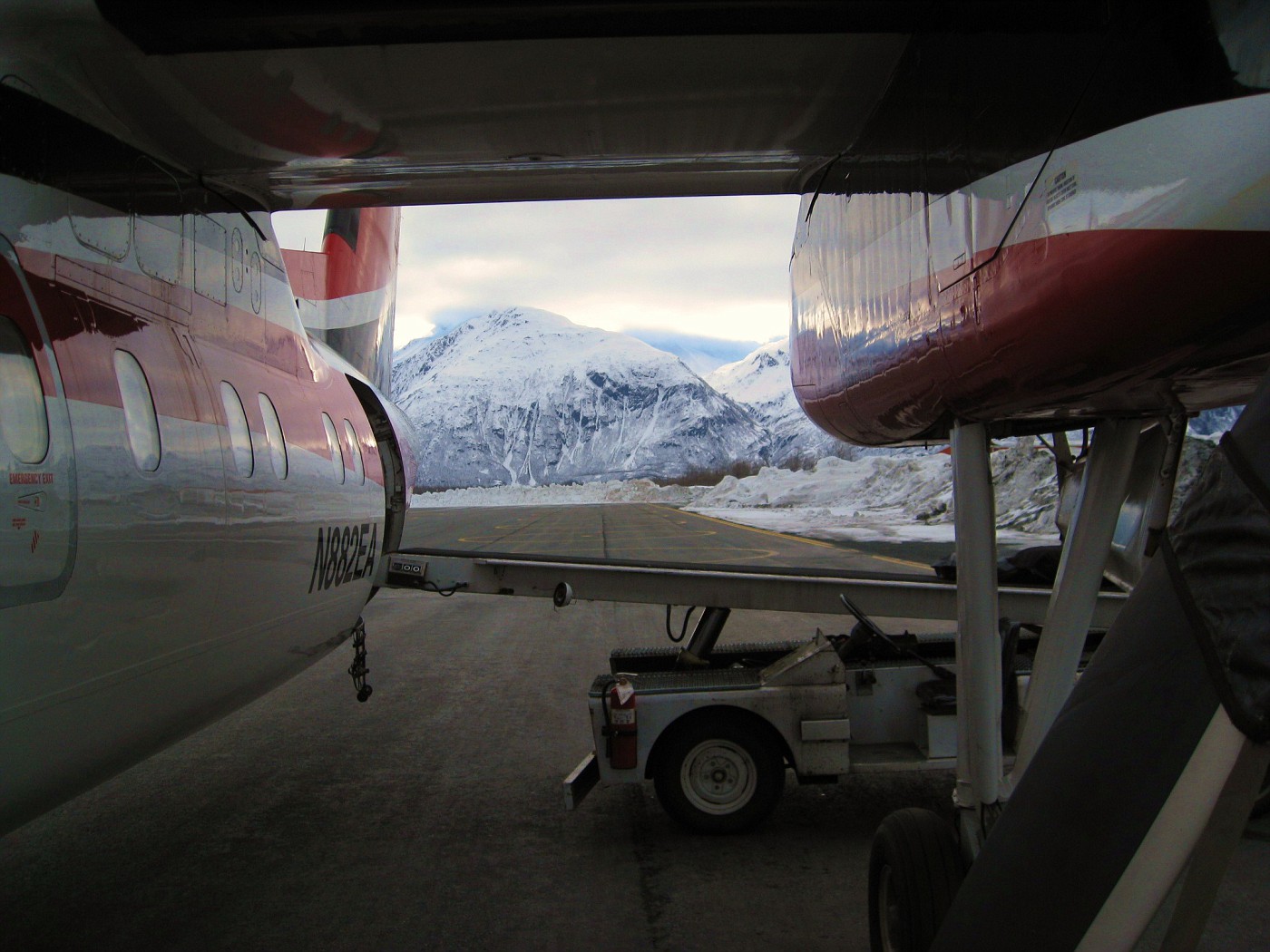
Thankfully the weather had improved considerably from the afternoon before. A large patch of clear sky on the horizon bode well for the flight ahead. I was fortunate to snag window seat 1D, at the forward exit row on the left side of the cabin. As the aircraft broke through the cloud layer shortly after takeoff, we entered a bright sunny world of magnificent snow covered peaks below which flowed multiple glaciers toward the clouds below. I stayed busy with my camera all the way through our descent into Anchorage.


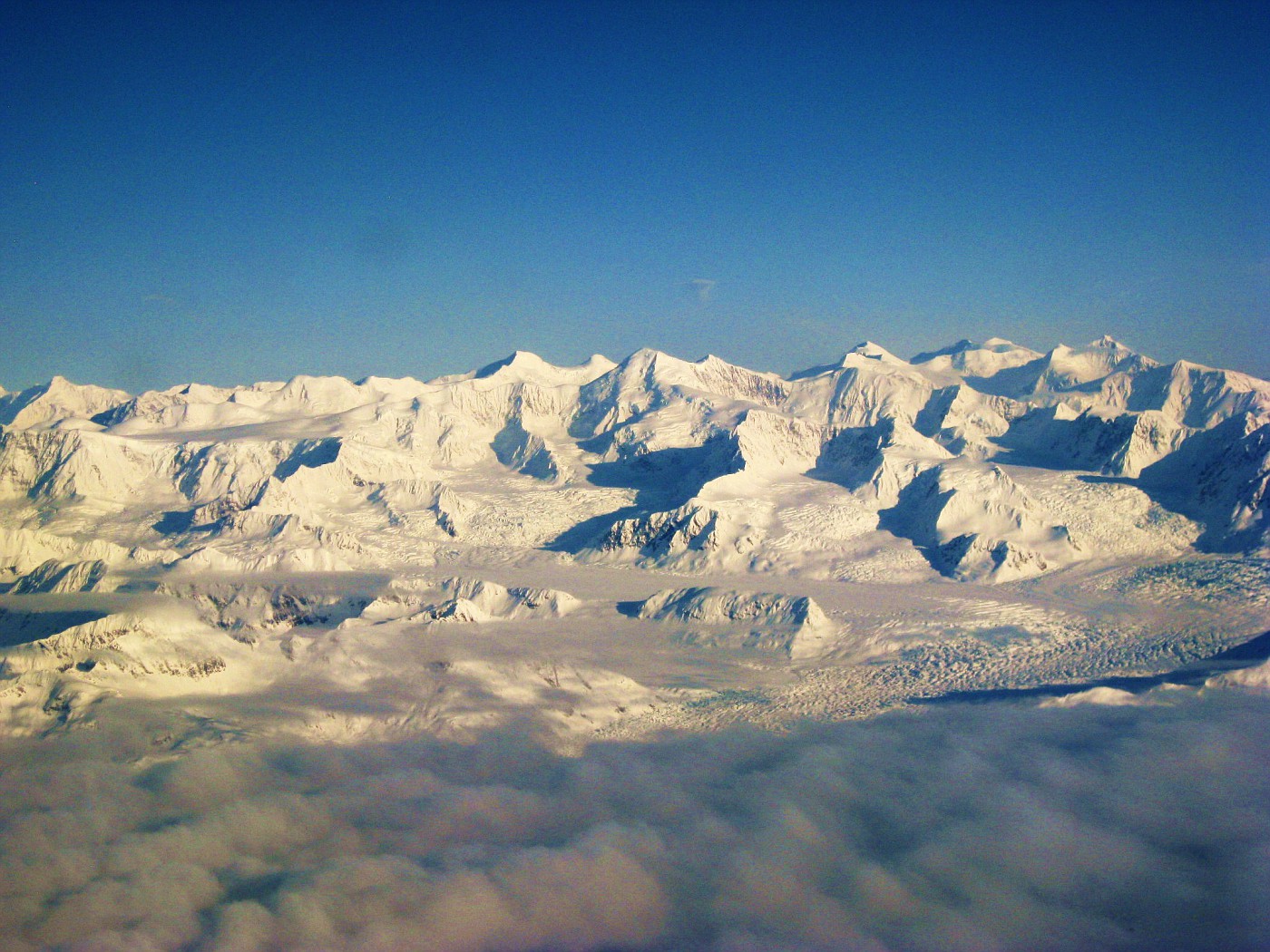
My original plan had been to use a one way award from Anchorage down to Denver with a two week stop in Seattle. However, with Alaska’s one-way instate awards going for just 7500 miles, I decided to first take an award flight to Nome, then start my one way 12,500 mile award journey to Seattle and Denver from there. As an added bonus, the Nome to Anchorage flight made a stop in Kotzebue, just north of the Arctic Circle.
I looked into spending a night in Nome, but the prices were ridiculous. $140.00 or more per night for rooms that per internet reviews were considered average to below average at best. I’ll come back on a summer weekend and camp outside of town. This trip will basically be an air tour.
Because there are no roads out to most of Alaska’s bush communities such as Nome and Kotzebue, airplanes are the best way to deliver people and goods. 737-200 Combis performed admirably for many years, having recently been replaced by 737-400s converted to Combis from Alaska’s mainline fleet. Generally, the forward half the airplane is utilized for cargo, with the rear half offering a normal passenger cabin. Boarding is via a self-contained stairway that extends from the rear passenger door.
The last time I flew N763AS was in April 2006, when it was a standard 737-400 configured to seat 144 passengers in two classes. Since its conversion to a combination passenger/cargo airplane, it now seats 72 economy class passengers in the back half of the plane starting at the second over wing exit window. Prior to today, I’d logged twelve flights covering 6980 miles aboard ship 763. Hopefully I’ll log that many and more on future visits to Alaska’s bush communities.
Unfortunately, the flights into Nome and Kotzebue were anticlimactic as clouds covered most of western Alaska. I found it interesting though that the terminal buildings at both airports appeared to be exactly the same. Perhaps there’s an Acme Airport Terminal kit available for purchase somewhere. Some assembly required.
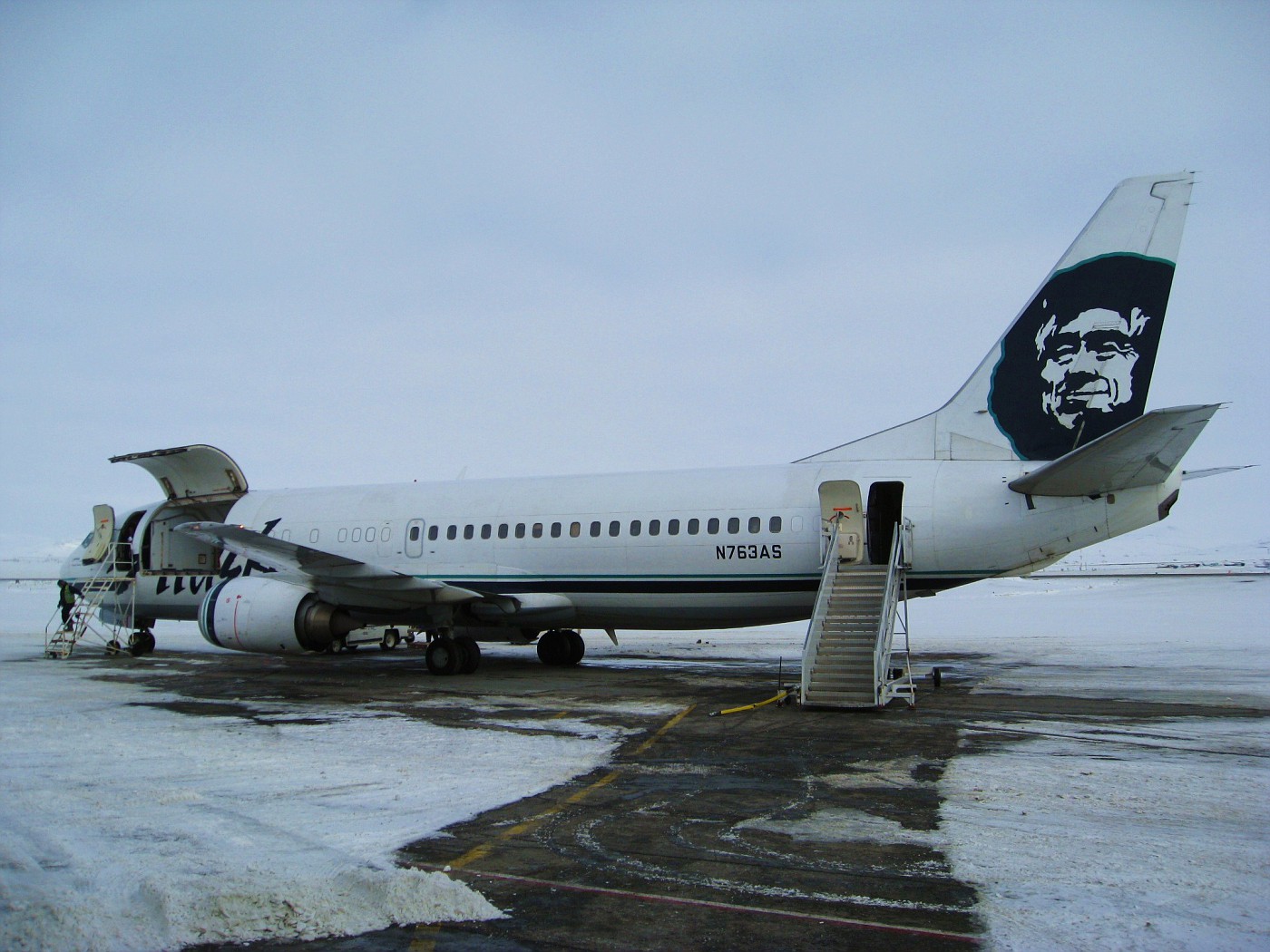
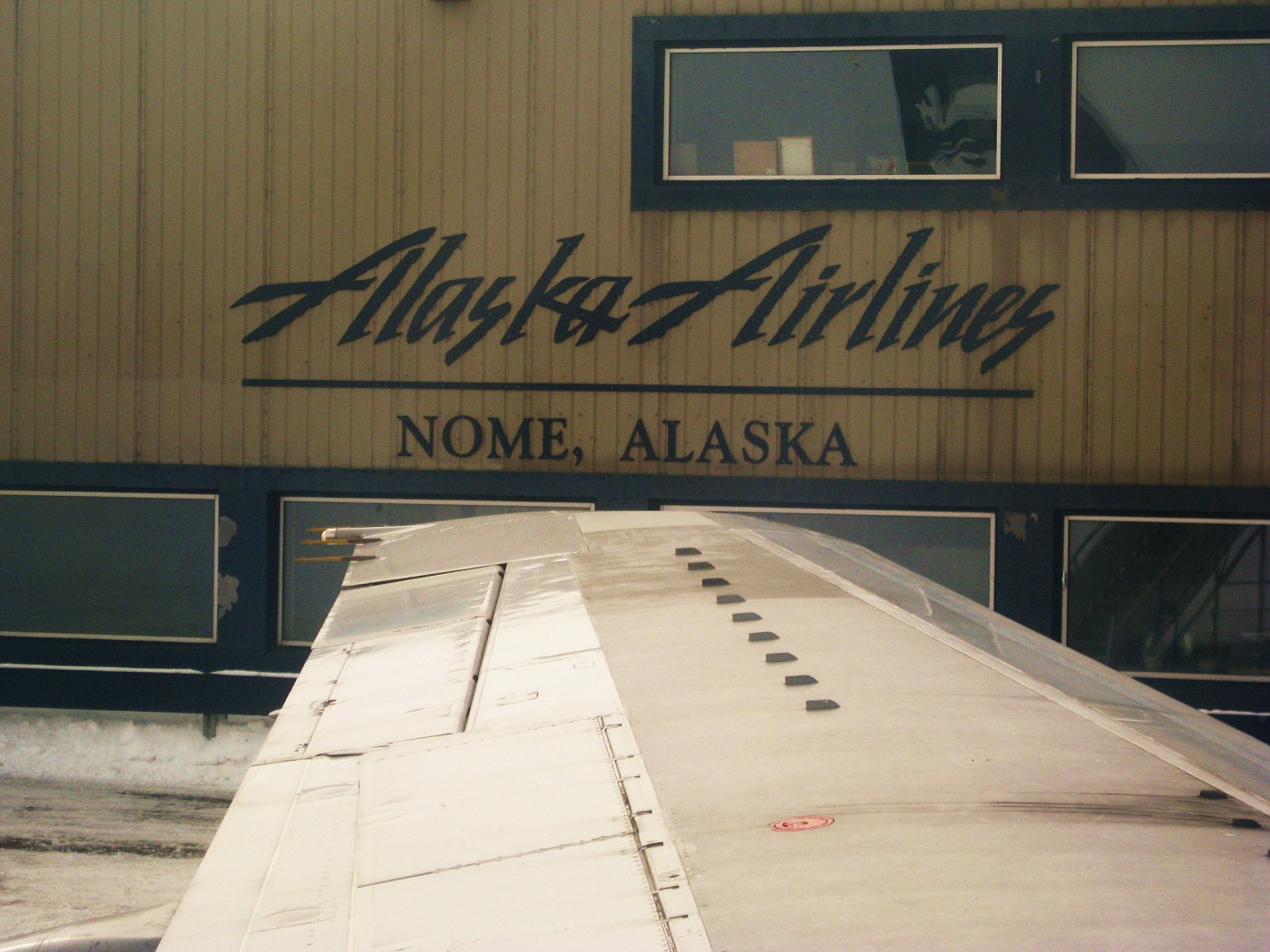
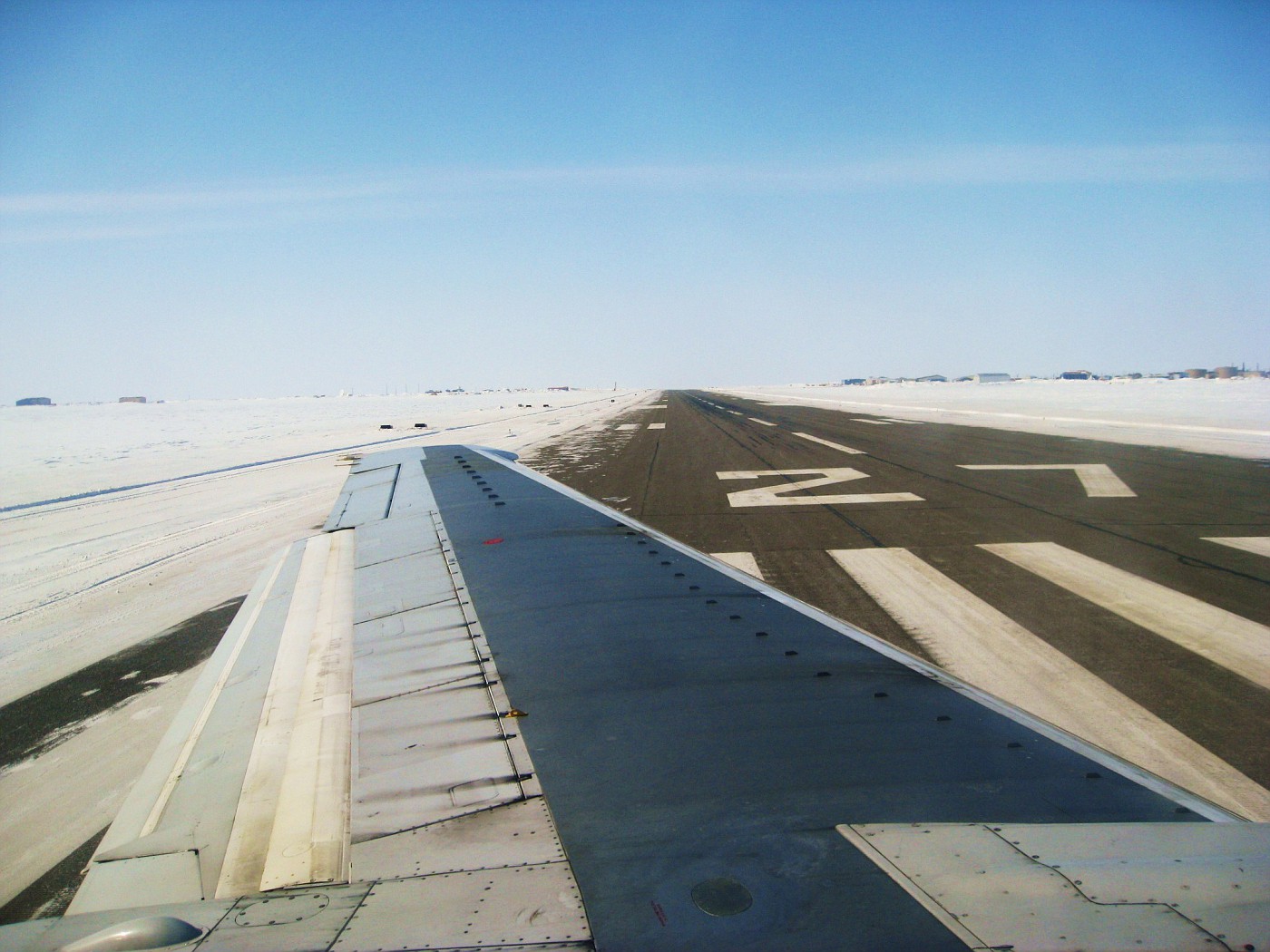
Transfer in Anchorage to my connecting flight down to Seattle was the stuff of dreams. I got off the flight from Kotzebue, casually strolled down the concourse to my Seattle flight and walked right on board. There was no rush, there was no line in the jetway and there was plenty of room in the overhead for my carry-on. I settled into my spacious exit row seat and reflected upon another nice day of flying.
On flights of three hours or longer, Alaska offers a choice of a cold turkey sandwich or a hot cheeseburger. Normally it’s one or the other but on this evening’s flight both were available. Each costs $5.00 and comes with a bag of chips. I think it’s a great deal compared to what I’ve seen offered on other airlines for generally more money. Alaska also treats its MVP Golds to a free drink in Economy, so I washed my burger down with an ice cold Alaska Amber. Ah… If you must fly domestic economy, this is a nice way to do it.
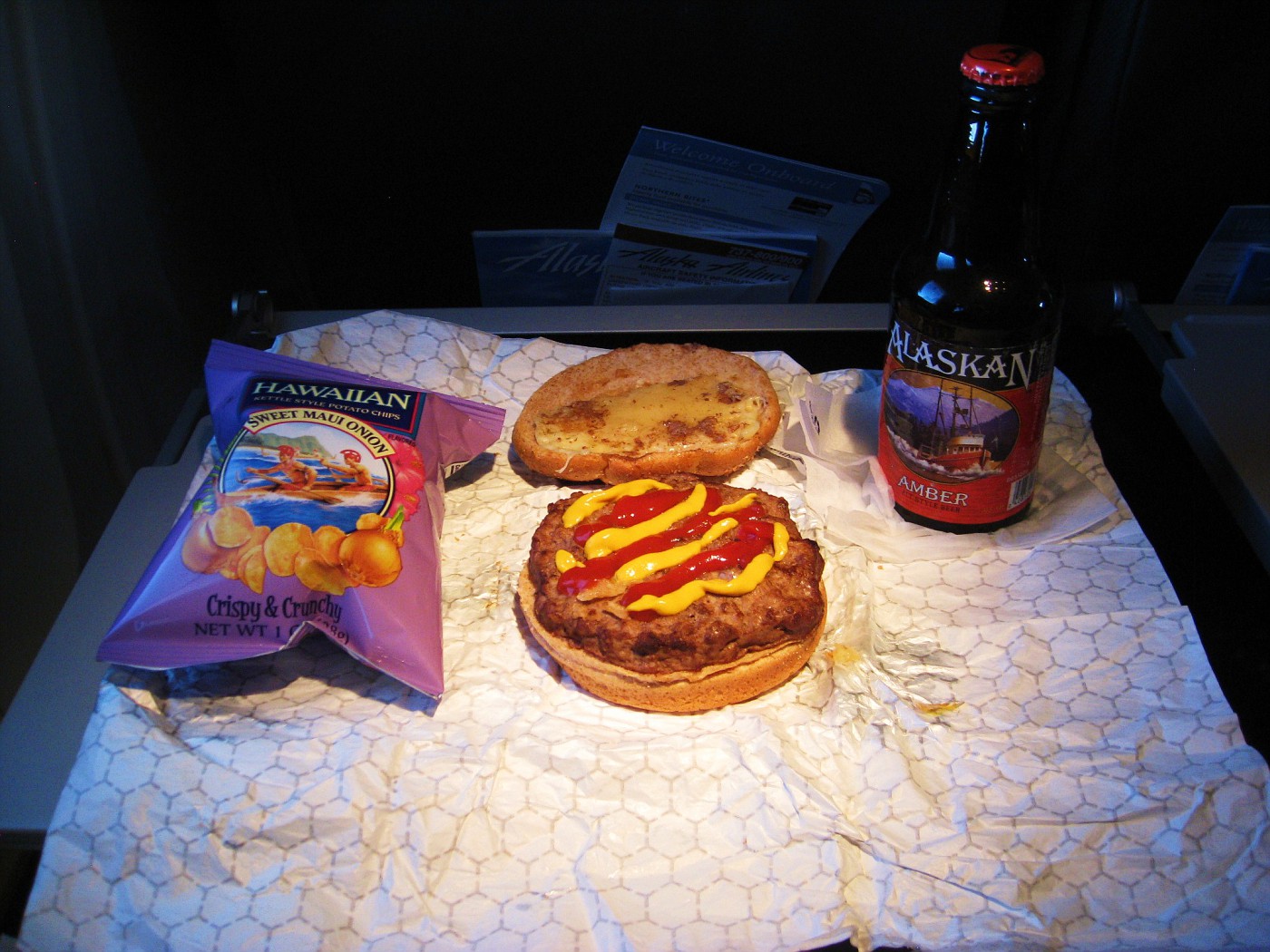
Thanks to Priceline, I spent a comfortable night at the airport Holiday Inn for about the same price I would have paid at one of the decidedly less comfortable airport motels.
April 14, 2009
Alaska Airlines Seattle – Los Angeles 5:00pm – 7:40pm 737-400
Northwest Airlines Los Angeles – Tampa 10:00pm – 5:34am A319-100
One way fares between Seattle and Tampa were going for about $100.00 each way back in March so I purchased three roundtrips over the next two weeks. Today’s run starts with a 5:00pm Alaska Airlines departure down to Los Angeles, connecting to Northwest’s 10:00pm nonstop across to Tampa. Interestingly, this ticket was purchased via the Delta Air Lines website though none of the flights are on Delta metal.
Alaska’s upgrade rules for MVP Golds are a bit different when the flight on Alaska is a codeshare issued on another airline’s ticket stock. Whereas on an Alaska issued fare I’d be able to upgrade 72 hours out, on a codeshare flight I can only upgrade on day of departure upon check-in at the airport. I’ve heard some MVPs grouse about this but I think it’s pretty nice Alaska allows us to upgrade at all under the circumstances.
Upon check-in I was told that I was at the top of the upgrade list but upon arriving at the gate I was informed that another MVPG had booked at the last minute to nudge me out. Alas. I took my seat in the reclining exit row and pondered an interesting coincidence: This is my 767th flight with Alaska Airlines. The aircraft operating this flight is N767AS. Go figure.
Flight time down to LAX was a quick two hours and four minutes. Upon arrival I headed over to Gate 35 to catch the American Eagle shuttle bus to AA’s commuter terminal where another bus would take me to Terminal 2 and my Northwest flight. Not so fast said the lady guarding the shuttle bus entrance. You must be a passenger on American Eagle in order to take the bus! But I’ve made this connection dozens of times in the past said I. She would have none of it. You must be a passenger on American Eagle in order to take the bus! she repeated. She further explained that the only way to get from Terminal 3 to my Northwest flight at Terminal 2 is to go back through security, head outside and walk over to Terminal 2.
It would seem things have changed. Apparently American Eagle no longer wants to shuttle non-AE passengers around LAX. Fair enough, but it’s now a big pain in the butt to connect between Alaska and Northwest what with the extra trip through Terminal 2 security. In addition to Northwest, Terminal 2 also serves a variety of international airlines so it’s busy place, especially in the evening with late night departures from Air New Zealand, Virgin Atlantic, Air Canada and Air France in addition to Northwest’s two departures to Detroit and Tampa. Additionally there is no elite lane at the security checkpoint so I spent another half hour standing in line before finally being deemed safe to proceed.
As an Alaska MVP Gold, I’m eligible for free upgrades on Northwest flights at the equivalent status of a Silver in Northwest’s WorldPerks program. Once again, I was told I was first on the list for the Tampa flight and once again I was informed at the gate that a couple of last minute Plats had shown up to spirit away the last available seats. Thankfully, I had the next best thing – a window seat in row 5 on the Airbus A319. As configured with Northwest, the first row of economy on both the A319 and A320 offer exceptional legroom and because there’s no bulkhead you can store your carry-on under the First Class seat in front of you.
As we pushed back from the gate, I took note of an A320 parked nearby that had been repainted in Delta’s new colors. Delta is wasting no time in repainting Northwest’s aircraft and I must say Delta’s colors are a big improvement over the bland grey Northwest livery.
We’re looking at four hours and five minutes over to Tampa tonight. That’s a quick flight considering the 2,150 mile distance. I reclined my seat shortly after takeoff and with the help of a Melatonin tablet slept most of the way to Tampa.
April 15, 2009
Northwest Airlines Tampa – Los Angeles 7:00am – 9:18am A319-100 First Class
Delta Air Lines Los Angeles – Salt Lake City 11:25am – 2:12pm CRJ-900
Delta Air Lines Salt Lake City – Seattle 3:15pm – 4:21pm MD-90
Alaska Airlines Seattle – Denver 6:45pm – 10:14pm 737-800 First Class
Our early arrival in Tampa meant an almost two hour layover before re-boarding the same airplane and flying back to L.A.. Thankfully I’d already been upgraded for the return flight with seat 1A having been pre-assigned. Since there are no airline lounges in Northwest’s TPA terminal, I stretched out in the gate lounge and caught another hour of fitful sleep.
Flight time to LAX was announced at five hours and ten minutes. I’d slept so comfortably on the flight out from LA that it would have been nice if the headwinds had blown in reverse and given us an extra hour or more of flight time. Ah well, I felt pretty good considering and the hot towel proffered shortly after takeoff did nothing to detract from that.
Coffee and orange juice were delivered in short order followed by a choice of an omelet or a bowl of Corn Chex cereal. Both entrees were served with a fruit plate, yogurt and a croissant or bagel. I ordered the omelet and since the bagel could not be toasted chose the croissant instead. The omelet was accompanied by sausage and was filled with a milky white cheese sauce with bits of veggies. Though nowhere near the best omelet I’ve ever had, it was reasonably tasty and certainly filling.
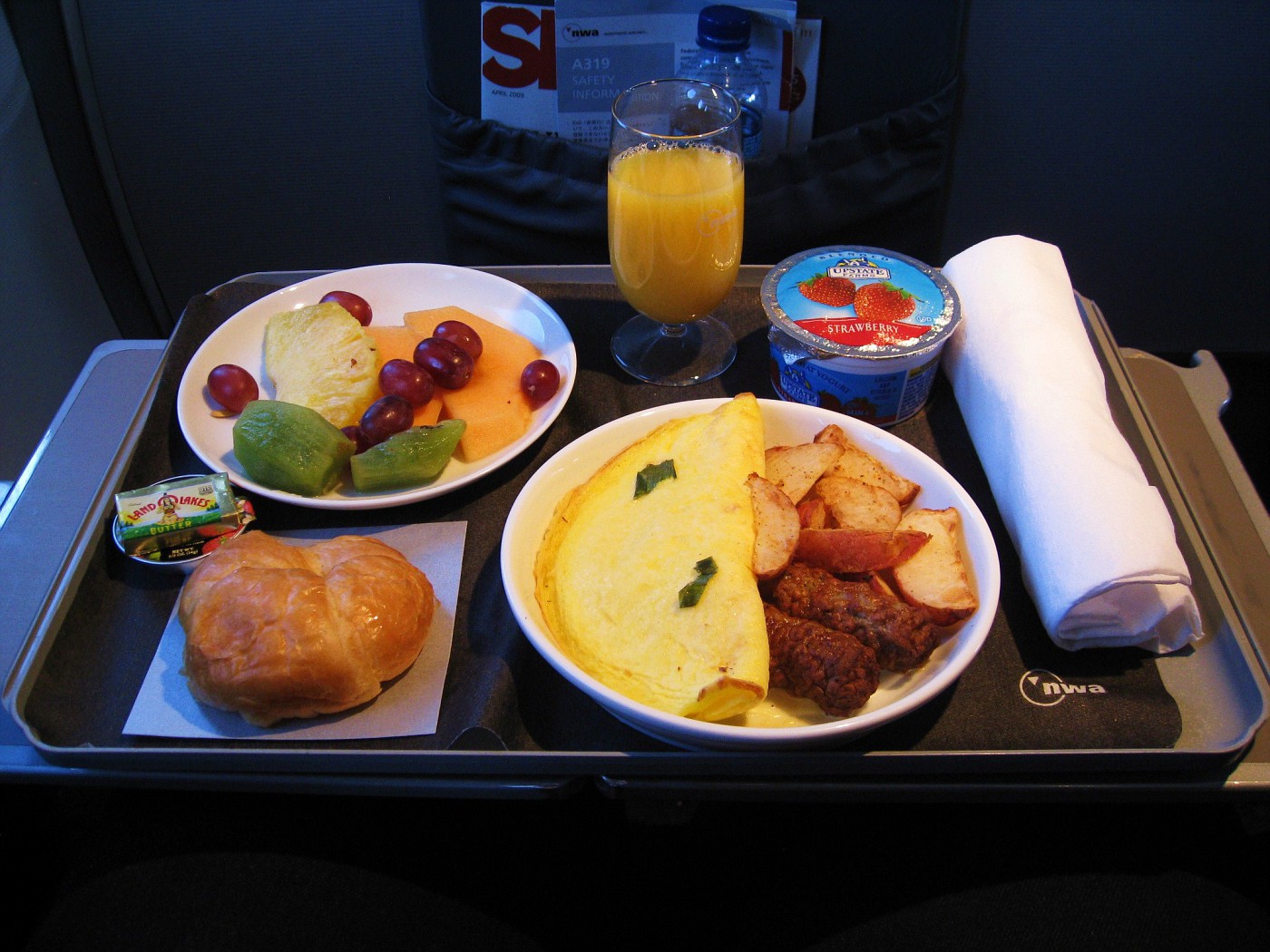
It’s interesting to see just how far the quality of domestic First Class meal service has fallen over the past twenty years. The breakfast I was served today, presented all on one tray, was pretty much what I would have received in Economy back in the seventies. In First Class on a route of this length back then, Northwest’s Regal Imperial Service would have presented a breakfast served course by course from the trolley complete with menus and silver service. Of course, back then I would have also paid the full First Class fare for my First Class seat instead of the $103.80 I paid today for a coach seat with a complimentary upgrade. So, no complaints from my quarter.
With the inter-terminal bus connection no longer an option at LAX, I hoofed it on over to Terminal 5 on foot. It was a beautiful clear day in southern California and it felt good to get out and enjoy the nice weather. The theme building at LAX, the one that looks like a giant white spider in the middle of the airport, was totally encased in scaffolding. The last time I was in that building was in the early seventies. Marriott provided the food service in the revolving restaurant and I remember dining on what may well be the finest Eggs Benedict I’ve ever eaten. TWA had just introduced its new twin red livery and we rued the loss of the old Starstream banner and the golden globe on the tail, one of the classic airline insignias of all time. Here’s how a 747-400 would have looked in that livery:
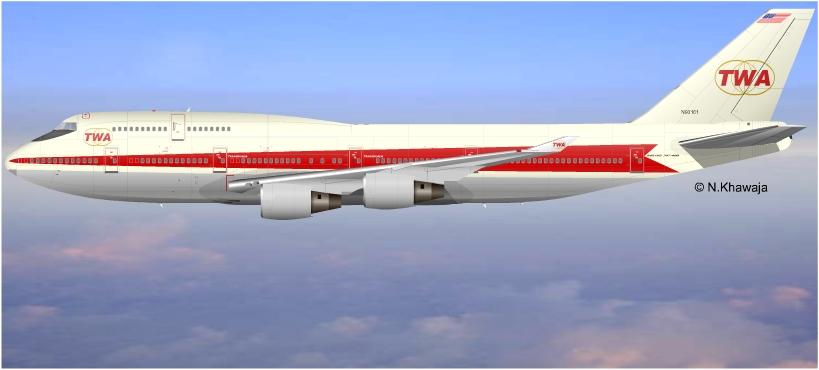
Aside from being a large and very attractive lounge, the Delta Crown Room at LAX Terminal 5 is the only domestic airline lounge I know of that provides showers. I had plenty of time before my connecting flight to Salt Lake City, so I enjoyed a hot shower, a shave and a fresh shirt followed by a coffee and Baileys at the bar before heading out to my gate. Flying doesn’t always have to be the unpleasant experience we so often read of these days. For frequent flyers, a lounge membership is a must and goes a long way towards smoothing the rough edges of modern day air travel.
A long and sleek CRJ-900 awaited Salt Lake bound passengers at gate 65. The airplane looked sharp in Delta’s new livery and because of its extended length, even included a First Class cabin. The load was light and pushback was right on time. On our way out to the runway, we taxied by one of Qantas’ new A380s. This was my first time ever seeing the huge aircraft and I must say it is quite an impressive sight from the vantage point of ground level on the taxiway as opposed to being twenty feet higher in the airport terminal. Those engines are massive!
In just one hour and thirty-four minutes we were transported from a nice spring day in Los Angeles to a blustery winter like day in Salt Lake City. Snowflakes flurried as we taxied to a jetway equipped gate on the B Concourse. On a day like today this was quite a luxury since most of Delta Connection flights disembark outside and walk into the terminal.
A little more than an hour later I was comfortably sat in the exit row of a Delta MD-90 as we climbed above the cloud layer and re-entered a world of bright warm sunshine. I was reminded of the old Clairol hair color ads from years ago: “Hate those grays, rinse them away” When flying, how about “Hate those grays, fly them away!” Works for me.
An automated phone message received the day before alerted me to the fact that I’d been upgraded to First Class on Alaska’s 6:45pm departure to Denver. This was especially good news to me since I hadn’t yet sampled Alaska’s new catering on short to medium range flights that didn’t compete with Virgin America.
Waiting at the gate was N849AS, one of the first 737-800s delivered to Alaska and one that I’ve flown eight times previously. Boeing 737-800s joined the Alaska Airlines fleet in 2005. They were essentially purchased to replace Alaska’s inefficient MD-80s which burned 1,100 gallons of fuel per hour to the 737-800’s 850 gallons per hour. My first flight on an Alaska MD-80 was in 1990. Over the next seventeen years I logged exactly 150 flights on Alaska MD-80s and managed to fly upon each and every one in Alaska’s fleet. Alaska has since retired its MD-80 fleet and currently operates 46 737-800s, of which I’ve flown 28. Since I keep track of such things, I’m well aware of all those aircraft that I haven’t flown. As with Alaska’s 737-200, 737-400 and MD-80 fleets, why not fly them all? For today however, I'll chalk up another flight on ship 849 for a total of 14,110 miles.
To those of you wondering how do I know if I’ve flown each aircraft, I log the registration numbers. Updated fleet listings can be gotten from a number of sources on the internet. Cross ‘em off as you go.
To those of you wondering why do I care if I’ve flown each aircraft, I’m just plane weird.
Another interesting stat I noticed when logging this flight in the 737-800 database: As of this flight, I’ve logged 150,000 miles on 737-800s. Sixty-five of those flights have come over the last four years aboard Alaska jets totaling almost 95000 miles.
So, what’s for dinner?
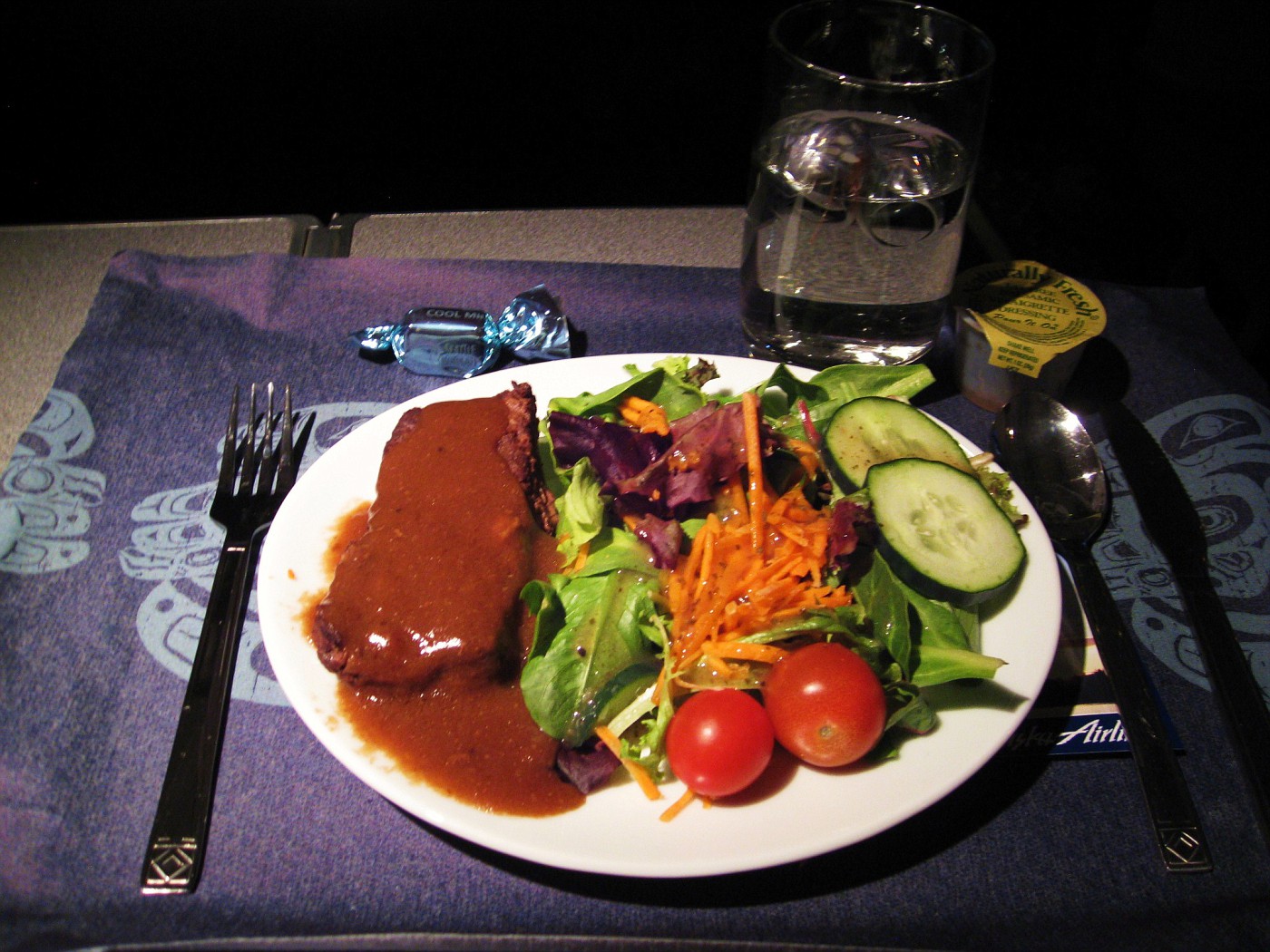
A small green salad accompanied by a small rasher of beef smothered in gravy. While tasty enough, this meal was not overly filling. I’ve had appetizers in International First Class that were larger. I was reminded of some of the smaller microwaveable diet entrees you see in the frozen food section of the grocery store. Still, it was better than a bowl of mixed nuts or nothing. Did I mention the delicious piece of chocolate for dessert? I really like that chocolate! There goes the diet. And what the heck – I’ll finish the meal with a coffee and Baileys please.